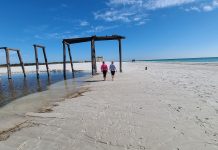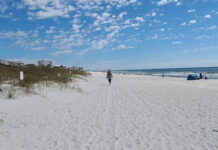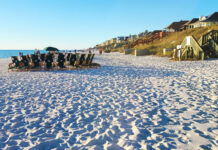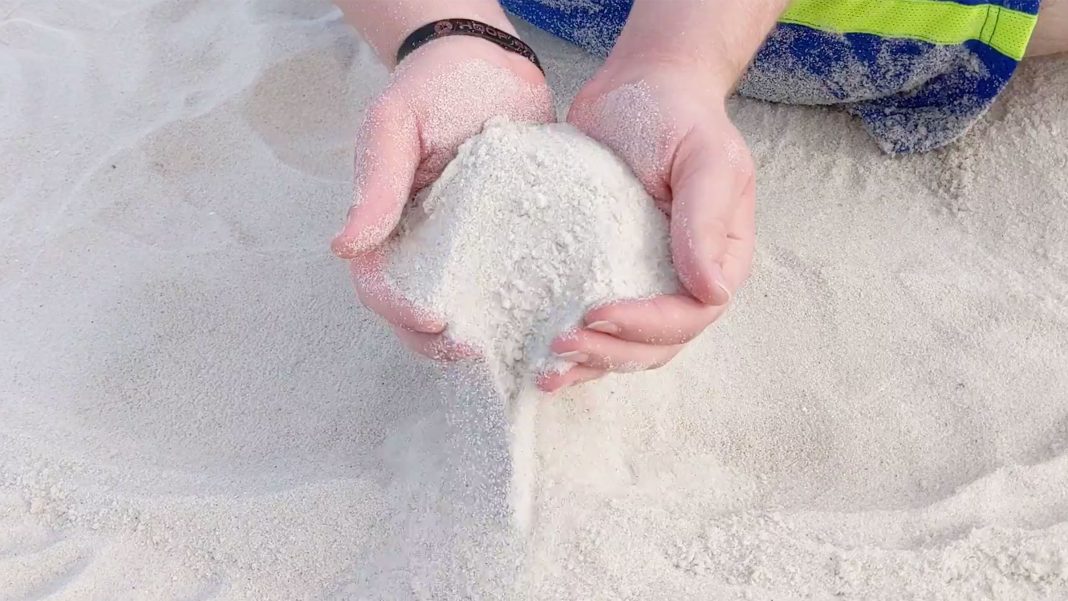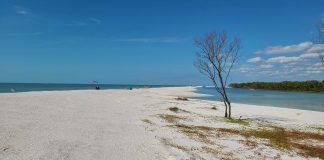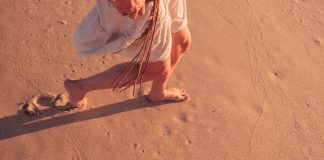Florida’s Panhandle and many West Coast beaches are famous for their white, powdery quartz sand, which is considered some of the finest and softest in the world. The sand’s unique composition, origin, and qualities make it stand out from beaches in other regions. The unique sands across the beaches is one of the best parts of the beach experience for me! And there is nothing quite like the experience of walking on White Quartz Sand.
Where the Quartz Sand Comes From
The origin of Florida’s white quartz sand traces back millions of years to the Appalachian Mountains. Here’s how the sand made its way to the beaches of the Florida Panhandle:
- Erosion of the Appalachian Mountains
Over millions of years, the Appalachian Mountains in Georgia, North Carolina, and Tennessee slowly eroded. Rivers like the Apalachicola and Chattahoochee carried sediments, including quartz particles, downstream toward the Gulf of Mexico. - Quartz as the Primary Mineral
Quartz, being a hard and durable mineral, survived the long journey from the mountains to the coast. It’s resistant to weathering, which means that as it was transported by rivers, it didn’t break down into smaller fragments as easily as other materials. - Deposition Along the Gulf Coast
As the rivers flowed toward the Gulf of Mexico, they deposited these quartz particles along the shoreline. Over time, this created the white sand beaches we see today along the Florida Panhandle and the Gulf Coast beaches. The quartz has accumulated and become the dominant component of the sand in many of these areas.
Why Quartz Sand Is So White
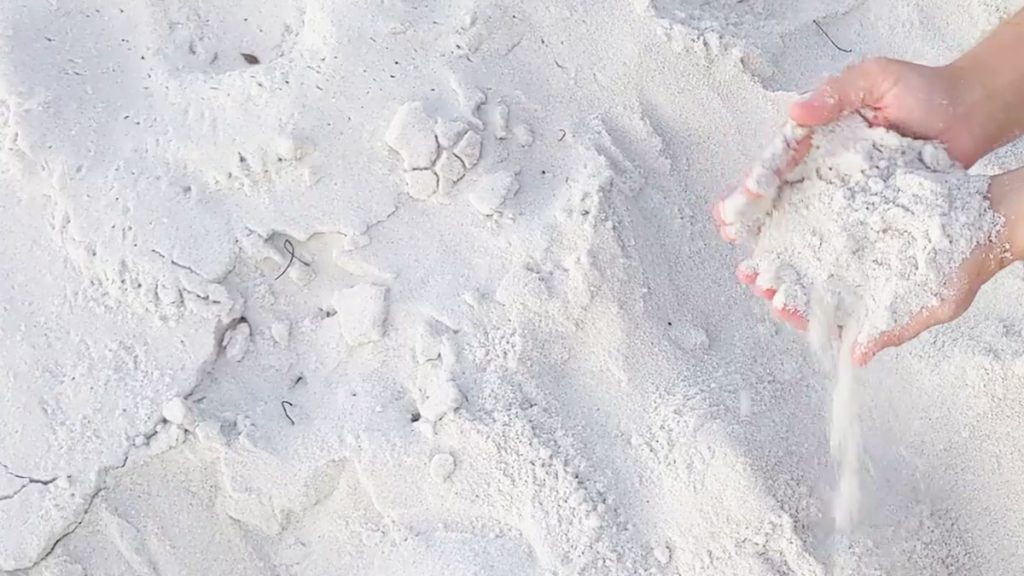
The stunning white color of the sand on these beaches is directly related to the purity and composition of the quartz.
Quartz’s Natural Transparency
Quartz is naturally transparent to slightly milky in color. When finely ground into sand-sized particles, it reflects light in a way that makes it appear brilliantly white.
Lack of Other Minerals
The quartz sand along Florida’s Gulf Coast is remarkably pure, with few impurities or darker minerals mixed in. In many other coastal areas, sand contains more feldspar, iron, or organic matter, which darken the overall appearance. In contrast, Florida’s Panhandle and many Gulf Coast beaches have minimal organic or mineral contaminants, allowing the quartz’s true color to shine.
Why Quartz Sand Is So Soft
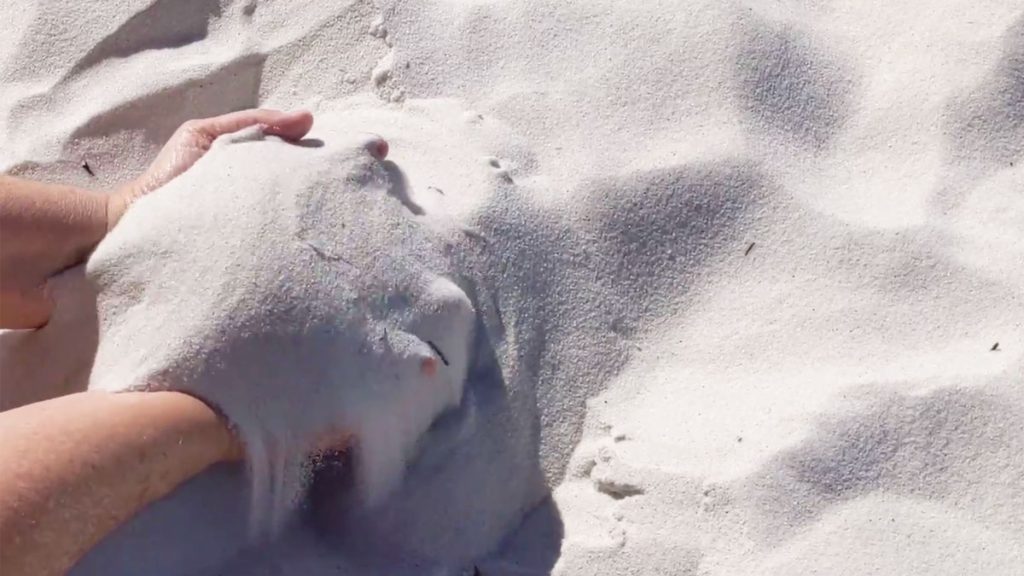
The softness of the quartz sand is another reason why it feels so amazing underfoot.
Rounded and Finely Ground Grains
Over millions of years of transportation from the Appalachians, the quartz particles were smoothed and rounded by the movement of water. This weathering process naturally wore down any sharp edges, leaving grains that are soft and rounded, rather than rough or jagged.
Fine Grain Size
The quartz grains that make up the sand on Florida’s Panhandle and many Gulf Coast beaches are typically very fine. This small particle size contributes to the silky feel of the sand. When you walk on it, your feet sink slightly into the soft, cushion-like surface, making for a comfortable, almost powdery sensation.
Cool to the Touch
Another characteristic of quartz sand is that it stays cool even in the heat of the day. Unlike darker sand, which absorbs and retains heat, the white quartz sand reflects sunlight, so it doesn’t become uncomfortably hot. This is why you can walk barefoot on these beaches even during the hottest parts of the day.
Quartz Sand vs. Other Sands
Many beaches around the world don’t have quartz sand and instead are composed of different materials, which affects their texture and color:
Silica and Volcanic Sands
Beaches in tropical regions, such as Hawaii, often have black, green, or red volcanic sands that are composed of basalt or other volcanic minerals. These sands can be coarser and rougher, with a much different feel from the soft quartz sand of Florida.
Coral and Shell Sands
In places like the Bahamas or the Caribbean, some beaches are composed primarily of pulverized coral and shells. These beaches tend to have pink or beige hues and feel grainier than quartz sand. Some of the beaches on Florida’s Gulf Coast have a mixture of quartz sand and shell sand making the color more orange.
Organic Sands
Beaches with higher organic content (like some in the Northeast U.S. or the Pacific Coast) often have a darker, more brown or gray appearance. These sands are usually coarser and absorb more heat than quartz. Some of the beaches on Florida’s Gulf Coast have a mixture of Quartz sand with organic content making it darker in appearance.
Other Unique Features of Quartz Sand on Florida’s West Coast
Durability
Quartz is incredibly durable, meaning that it doesn’t break down or degrade as quickly as other types of sand. This contributes to the long-lasting beauty of Florida’s Panhandle beaches and beaches along the Gulf Coast.
Limited Shell Content
Unlike many other beaches that have a high concentration of shells mixed into the sand, the quartz beaches have fewer shells overall. This makes for a smoother walking experience, with fewer sharp fragments underfoot.
Shifting Tides and Wind Patterns
The fine quartz sand is easily moved by wind and water, which helps create the beautiful, undulating dunes seen along many of Florida’s Panhandle beaches. These sand dunes are an important part of the coastal ecosystem, helping to protect the shore from erosion while creating stunning landscapes.
Quartz Sand Beaches in Florida
The best places to experience Florida’s famous quartz sand include:
Pensacola Beach – Famous for its ultra-soft, fine quartz sand that feels like powdered sugar beneath your feet.
Navarre Beach – Another Panhandle gem with pristine quartz sand, perfect for relaxing barefoot walks.
Panama City Beach – Known for its vast stretches of white quartz sand, which stays cool even during hot summer days.
Grayton Beach and 30A – These beaches are a natural wonder, where the fine white quartz sand meets the vibrant emerald waters of the Gulf.
Destin – Often regarded as one of the best beaches in the U.S. due to its silky soft, white quartz sand and crystal-clear water.
Siesta Key – famous for its fine, white quartz sand that is 99% pure quartz. The sand here is soft and cool to the touch, making it one of the top-rated beaches in the U.S.
Marco Island – primarily composed of fine, white quartz, much like many beaches along Florida’s Gulf Coast. It has a soft, powdery texture that feels cool underfoot, but also has rich deposits of seashells making the sand a bit coarser in some areas.
Quartz Sand in Other U.S. States
Alabama – The quartz sand beaches of Alabama’s Gulf Coast, such as Gulf Shores and Orange Beach, are part of the same geological system as Florida’s Panhandle. These beaches have similar white quartz sand, originating from the Appalachian Mountains, although some areas may contain more shell fragments.
Mississippi – Mississippi’s Gulf Coast also features quartz sand, but it is typically mixed with more shell and organic material, making it slightly darker and coarser than Florida’s beaches.
Texas – Texas beaches along the Gulf of Mexico, like Galveston, have sand with less quartz content. The sand here tends to be darker and coarser, as it includes more organic materials and mineral fragments like feldspar and clay.
North Carolina and South Carolina – The beaches of the Outer Banks (North Carolina) and Myrtle Beach (South Carolina) also contain quartz sand, but it’s typically mixed with other minerals, leading to a tan or beige hue rather than the pure white seen in Florida’s Panhandle.
Great Lakes Region – Some beaches along the Great Lakes (particularly in Michigan) have white quartz sand. These sands were formed by glacial activity and are often fine and soft, though they tend to be mixed with more local minerals, giving them a slightly different texture and color compared to Gulf Coast quartz sands.
Quartz Sand in Other Countries
Bahamas – The Bahamas have beaches with a mixture of quartz and coral sand, giving many beaches their famous pink hue. While quartz is present, the predominant component is broken-down coral and shells.
Australia – Australia is home to some of the whitest beaches in the world, particularly along the Whitsunday Islands and Jervis Bay. These beaches contain extremely pure white quartz sand, similar in appearance and texture to Florida’s Panhandle beaches. Hyams Beach in Jervis Bay is even recognized for having the whitest sand in the world, according to the Guinness World Records.
Sardinia, Italy – The island of Sardinia in the Mediterranean Sea has beaches with bright white quartz sand, particularly in the Is Arutas area. The quartz grains here are larger, almost pebble-like, giving the beaches a distinctive texture.
Greece – Some beaches in Greece, such as those in the Aegean Islands, also have quartz sand, though it is often mixed with limestone and volcanic rock, leading to a wider variety of sand colors, including white, black, and pink.
Mexico’s Yucatán Peninsula – Playa del Carmen and the beaches of the Riviera Maya have soft, white sand that contains a significant amount of quartz. This sand, combined with finely ground coral, gives the beaches their brilliant white color and smooth texture.
The Maldives – Many of the Maldives islands feature a mixture of quartz sand and coral fragments. While quartz is present, the sands here are primarily made up of crushed coral, which gives them a slightly different texture, though still soft and powdery.
Why Florida’s Quartz Sand Stands Out
While quartz sand exists in other places around the world, the purity and unique composition of the quartz sand along Florida’s Panhandle beaches make it special. In other regions, quartz may be mixed with more organic material, feldspar, or volcanic rock, which can change the sand’s texture and color. In contrast, Florida’s quartz sand is exceptionally pure, giving it the bright white, soft, and powdery feel that has made it world-famous.
Geological factors and climate also play a role in how quartz sand is distributed across different parts of the world. In tropical regions, beaches tend to be made of coral and organic material, while in temperate and mountainous areas, the sand is often composed of quartz and other minerals derived from weathered rock formations.
So, while quartz sand is not exclusive to Florida, its presence, purity, and the cool, soft feel underfoot make Florida’s Panhandle beaches and other beaches along the Gulf Coast of Florida uniquely brilliant and special.
It is a natural treasure, offering an unmatched beach experience and a dream for walking barefoot, hiking and playing in the sand. The sand’s unique origin from the Appalachian Mountains adds to its mystique, creating some of the most iconic beaches in the world. Next time you’re strolling down Pensacola Beach, exploring the dunes of Grayton Beach, or relaxing in Panama City, revel in the beauty and serenity of nature bringing us the most natural white quartz sand to enjoy!


